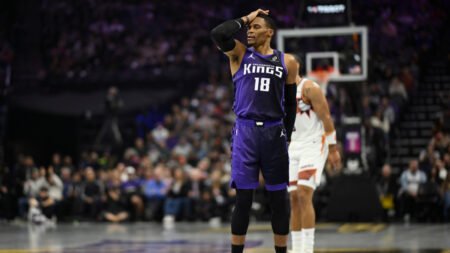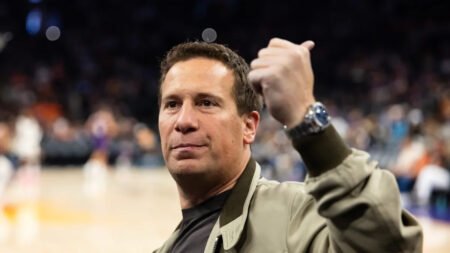Once again CBS Sports presents our annual Candid Coaches series, which spotlights relevant topics and issues in men’s college basketball. Gary Parrish and Matt Norlander polled roughly 100 coaches in recent weeks on a variety of subjects. Coaches spoke on background and were provided anonymity to offer unfiltered opinions. This is the second installment in our 2025 survey.
The House Settlement that took effect this summer generated a lot of money for attorneys and also returned something akin to recruiting regulations to college athletics. In theory, each Division I athletic department now has up to $20.5 million to spend on athletes however it sees fit. In theory, name, image and likeness deals that were more or less unlimited in recent years are now supposed to be scrutinized with anything that looks more like pay-for-play than actual NIL disallowed.
In other words, there are rules again.
The days of coaches getting a group of boosters to stack money so that they can deliver it to a prospect in exchange for nothing more than his commitment are supposed to be over. But are they? With that in mind, my colleague Matt Norlander and I decided to ask more than 100 college coaches the following question:
Assuming there now is what amounts to a salary cap in college athletics, do you trust that your competitors will recruit within the rules?
No: 89%
Yes: 11%
Quotes that stood out
From coaches who answered “No.”
- “I do not trust that most high-level competitors will stay within the rules. There is too much at stake. Personally, I would rather it be that way. It allowed opposing coaches to know who they were recruiting against and make the decision to stay involved or not.”
- “No. That has never happened.”
- “Absolutely not. I don’t think there’s one coach who’s going to say we’re going to follow the pillars of the NCAA constitution, get the f-ck out of here.”
- “No, everybody will attempt to be as creative as they can to skirt the rules and gain a competitive advantage. There will also be a lack of oversight & governance.”
- “No, at least not 100%. Until we have a governing body that can enforce rules and levy out ‘real’ punishments, those who have always found a way or ‘cheated’ will continue to do so.”
- “We are in the SOUTH region of the United States. There are no rules, only getting wins. Let’s be real.”
- “I do not trust our competitors to recruit within the rules at all. (We are in the SEC, remember). And a fair salary cap at our level should be around $8 to $10 million per roster.”
- “No. The precedent has been set over the last couple of years with how recruiting has been done. Now they have even more of a direct line to donors/money-people.”
- “No. If you get more than two people to say yes, you should cancel all their other answers. It’s too competitive. We live in a competitive environment. Coaches are going to do what they need to get players.”
- “Hell no. Ask [Los Angeles Clippers owner Steve] Ballmer!”
Candid Coaches: Which school made the best college basketball coaching hire in 2025?
Matt Norlander
From coaches who answered “Yes.”
- “I think you have to [follow the rules now]. In my opinion, this isn’t five to 10 years ago — when programs had to figure out how to hide a $10,000-to-$50,000 payment. You are 1759421297 talking about hiding hundreds of thousands of dollars, and in some cases millions. Maybe I am naive, I just don’t see how people will hide that amount of money.”
- “I believe that at the low/mid-major level there will be adherence to the rules because of lack of funds/opportunity to go beyond.”
- “Do I think 51% of the guys will follow these rules? Yes. Do I think 80%? That’s pushing my optimism.”
The takeaway
This question and the answers illustrate something I’ve been writing and talking about since before the House Settlement even became a reality — that a salary cap in college basketball, particularly a salary cap in college basketball that will differ for different programs even in the same conferences, was never going to work as currently constructed. Think about it: When the salary cap was effectively zero for decades and decades and decades, cheating was rampant in recruiting with ambitious coaches trying to create advantages and beat-down coaches just fighting to keep up. So why would any of that change now?
Hard caps are still hard caps.
And the same types of coaches who used to bust right through them before will simply bust right through them again, by any means necessary, after making the assessment that the possible reward — i.e., wins, championships and millions of dollars in contract extensions — outweighs any perceived risk.
It’s an accurate assessment.
Think about all of the coaches who have gotten in trouble for so-called cheating over the past decade. I don’t have to name them. You know who they are. Now think about how many of them still have the jobs they had or have recovered nicely with similar or even better jobs. In this sport, cheating has never ended careers as much as losing does. So every set of rules ever created has been broken over and over again by countless individuals for as long as rules have existed. And I always figured the return of what amounts to recruiting rules, after a brief period of anything-goes, would lead to the return of strong-ass offers and under-the-table payments.
As you can see, coaches agree.
Nearly nine out of every 10 coaches we asked told us they do not trust their competitors to recruit within the rules. All but one of the “Yes” votes came from low-major and mid-major coaches with their rationalization being, as one coach quoted above told us, that the money to cheat with just might not be available too much at the low-major and mid-major levels. With his tongue firmly in cheek (at least I think), one high-major coach actually told me he doesn’t believe his competitors will follow the rules because he already knows he’s not going to follow them.
“You know what conference I work in,” the coach said. “How much do you think we’re winning if I’m following these new rules? And here’s the other thing: At least before, we all knew the rules, and then we could decide whether or not to break them. But now the rules are confusing. People either don’t understand them or don’t believe in them. And none of us believe anybody is really following them. It’s messy.”
Yeah, it’s messy.
As I’ve explained before — including as recently as last month when Arkansas athletic director Hunter Yuracheck more or less publicly co-signed what coaches told us — based on the way the rules are written, once some power-conference athletic departments spend, in some cases, roughly 75% of their $20.5 million in revenue-sharing on their football programs, there should be Big East men’s basketball programs, and even some Atlantic 10 men’s basketball programs, with more money to roster-build than various SEC, Big Ten, Big 12 and ACC men’s basketball programs. But do you really think coaches in those four leagues — some of the biggest coaches in the sport at some of the best programs in the nation — are just going to sit back and lose transfer-portal targets to Providence and Saint Joseph’s over a lack of money?
No chance.
Unsurprisingly, that’s precisely what the coaches told us.
Previous 2025 Candid Coaches questions
Read the full article here














